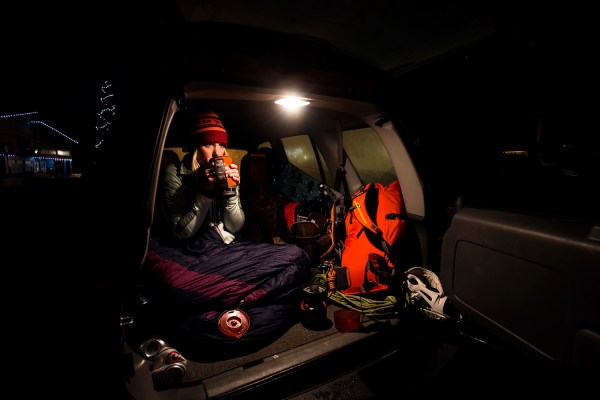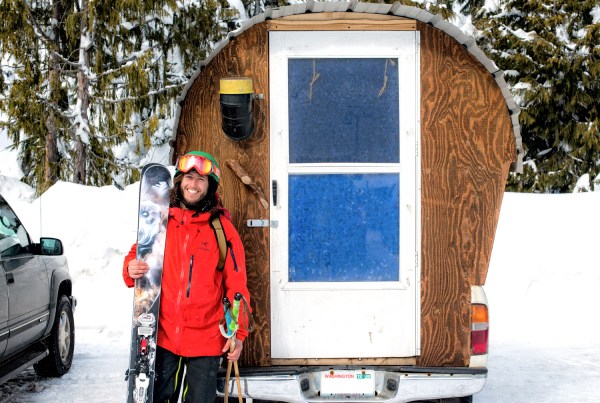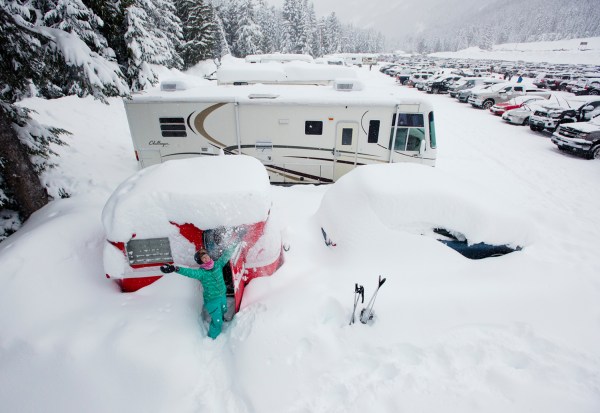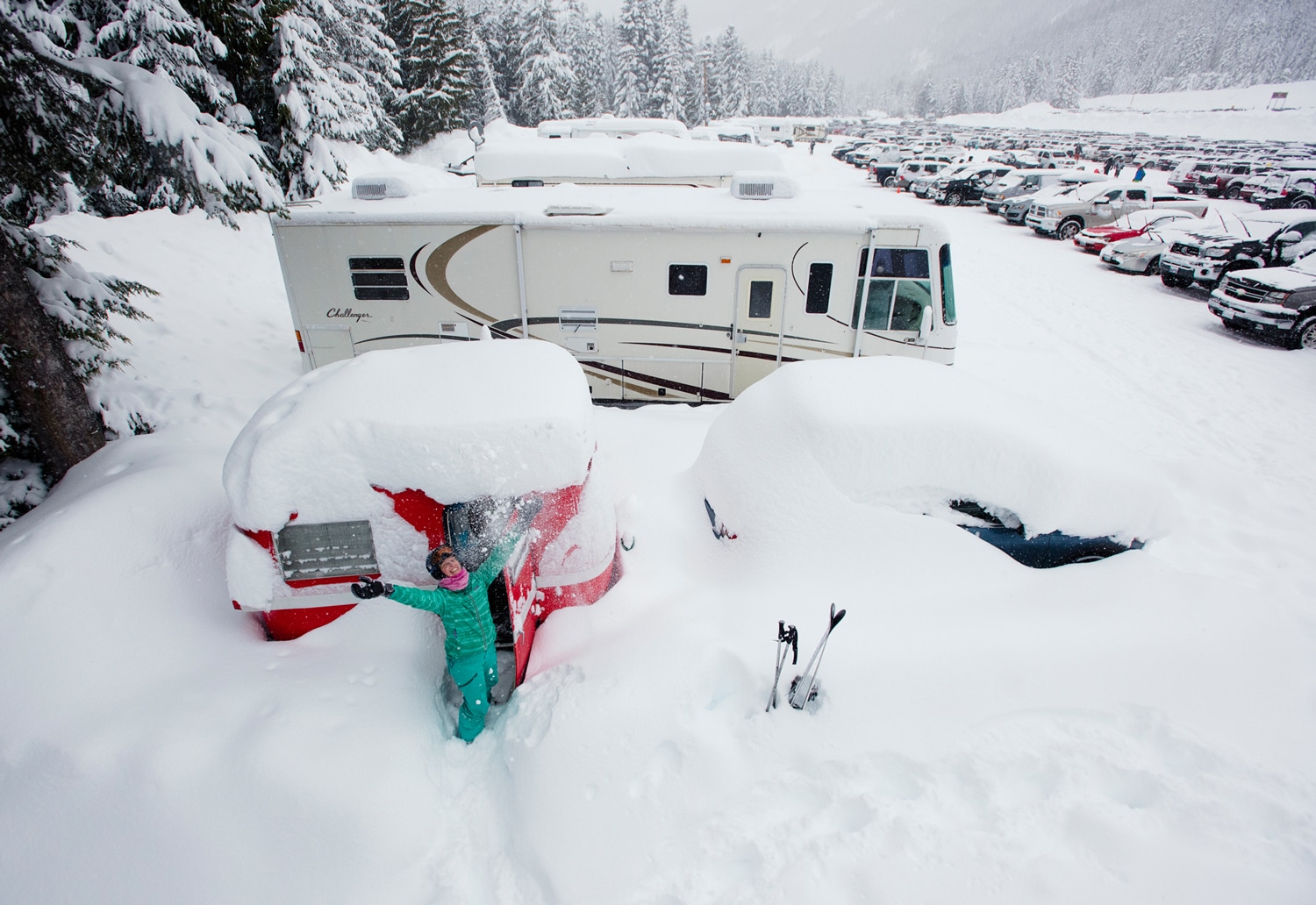Have you ever wished to disconnect from reality, hit the road, and to be free to go anywhere?
In August of 2015, I couldn’t take thinking about the open road any longer. After months of weighing my options, I purchased a recreational vehicle (RV). At 23′ long, it’s small and agile enough to go anywhere I want, but big enough to live in.
So, now that it’s winter, how has the RV done as the temperatures have plummeted? Is an RV the best cold-weather option for you? What other options are there?
To help you decide, I’ve listed five popular adventure vehicles I see on the ski hill.
1. Customize the Back of Your Car or Truck
After an epic ski trip to Canada, I dropped off my friend Dan in the parking lot where he’d left his truck. I felt guilty leaving him there. He isn’t a bum, isn’t homeless either, but he had chosen to live in his truck.

Your home doesn’t need to be a big RV. You can live small and still be comfortable. This holds true at a ski area as well. Here are some tips for living out of your vehicle:
- Build a bed, which is often just a platform with storage underneath. Build cabinets in the space below if you are extra handy.
- If you have a car, just fold your seats down. Before I bought my pre-RV wagon, I made sure to test this out and crawled in to see if I could sleep there.
- Buy a small cookstove. Some stoves can struggle in the cold, so it can help to put a pad underneath the fuel canister if using on top of snow.
- Have a nice chair and table you can set up outside on those clear days when it isn���t snowing.
- Storage is important. Buy waterproof boxes in case you have to leave them outside at night. Better yet, buy a roofbox for extra storage. Having wet skis in your car is never ideal.
2. #VanLife
If you are handy, customizing a new or used van yourself is cheaper than buying one already outfitted for adventure. You can customize nearly anything, and can find countless resources online for the details you need to know.
- Keeping warm in the winter is always an issue. Besides insulation, a cheap and simple option is to buy a propane heater—but be sure it’s rated for indoor use. (A carbon monoxide detector can be a good idea even for an indoor-rated one.)
- If possible, find a van with a chassis with four-wheel-drive. This will make it a lot easier to get your vehicle out of the parking lot after five feet of snow has fallen!
- If you are customizing your van, insulating your pipes against the cold is paramount. If water isn’t important to you, then you can do what most RVs end up doing whenever it gets colder than 15-20 degrees out—you either leave your heat on full time (which can be risky if power or heat fails and your pipes freeze) or you remove all the water. Some vehicles come with a winter package or are built to withstand all four seasons, but even they can freeze up.
- Ski storage is important and a roof rack isn’t always a practical option. Take a look at hitch boxes. Personally I’m building a hitch rack that’ll hold my rooftop box for extra storage.
3. Build a Homemade Camper onto a Truck or Trailer

My friend Adam has an old pickup truck with 250,000 miles on it. On the back of the truck he built a miniature home with a peaked roof, chimney and even a mudroom porch! It’s lovingly called the Gypsy Wagon. Adam’s version 2.0 is a miniature house built onto a trailer. I asked him for advice and what he loves about his setups.
- In the winter, a must-have is a fan for moving heat around, as well as windows that open and close for controlling the temperature.
- Make use of old windows, doors and other homebuilding supplies; salvaging saves money and keeps waste out of landfills.
- You get to build a unique home on wheels with your own two hands.
- You can customize the space for your gear, and you can build on additions.
4. Buy a Four-Season Camper
Buying a truck and camper is a versatile option. When I was in Southwest Utah, my RV couldn’t manage many of the narrow dirt roads that are commonly washed out by flash floods. Worse yet, when I established my camp and ran out of propane or food, I had to pack up everything in order to drive to town.
Having a camper avoids uprooting your camp. You can detach your camper and make runs to town (or to climbing crags) without having to bring your entire home with you.
- There are great options for cold-weather use that you won’t find in many RVs or trailers.
- If you already have a truck, then buying a camper can be a great option. You won’t need to maintain two separate vehicles.
- A camper is compact and comes with all the comforts of home, such as a stove, fridge and microwave. Homemade meals save you money—lunch in the ski lodge will become a thing of the past.
- You can easily have four-wheel-drive to get you onto the mountain passes and into snowy ski area lots.
5. Go Big and Get an RV
An RV is a big purchase. Not only do you have to store it and/or park it, but there is the added cost of maintaining a second vehicle.

However, unlike the heading suggests, an RV can be small and efficient. My 23′ Winnebago View averaged 15 to 16.5 mpg on a 6-week road trip throughout the Southwest. By and large, though, if you are looking to save money an RV is hardly the way to go. But, if you are looking for added comfort, space and amenities, then the pluses can outweigh the negatives. Often, those conveniences make all the difference as to whether your family comes along with you to the mountain.
- Rent an RV or two and see what they’re like in the cold. It’s worth the money and time to see if an RV is really for you.
- Be sure that you have the space to park your RV at home, under a cover if possible.
- RVs are challenging in the snow, but they can do better than you’d expect with good tires and chains.
- Keep a big shovel on hand to dig yourself out and keep ice/snow off your roof. If cleaning your roof use a broom, plastic shovel or your hands.
- Understand your power system and consider backup sources, such as an external generator or shore power. Some resorts have shore power that ranges in cost from $20 to $40 per night.
- If you have water in your RV, then be sure to have backup sources of heat. I have an indoor-rated propane heater, my coach generator and an external generator. Having your RV freeze in the winter is a very real problem. Every vehicle is different, but often the safest course of action in really cold regions is to run your RV dry, which means no water. As such, carrying 5-gallon jugs is common.
- Be prepared to always be working on one problem or another. RVs are a work in progress and take a certain amount of love and consistent maintenance.
- Skip the line at the lodge and make your own food in your RV.
No matter what vehicle you choose, the mountains are calling. Hit the road, open the windows and let the air of freedom soothe your soul. Take it from a newly initiated RV greenhorn—I haven’t looked in the rearview mirror yet.
Have any other winter adventure vehicle tips? Please share them in the comments below.
